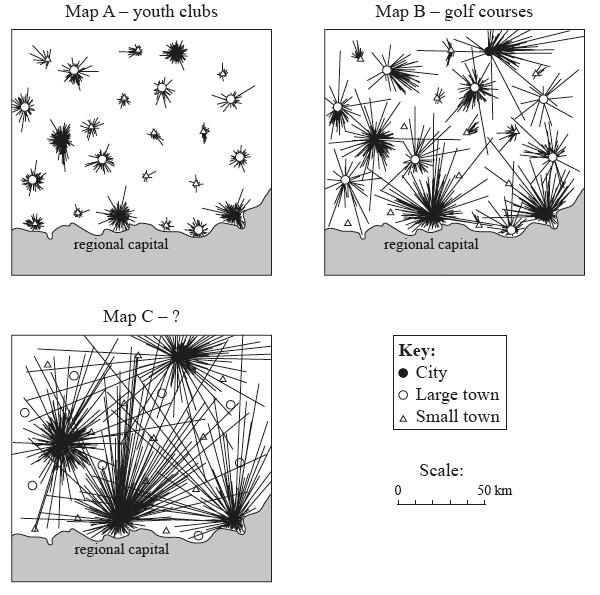| Date | November 2013 | Marks available | 2 | Reference code | 13N.2.sl.10 |
| Level | SL only | Paper | 2 | Time zone | |
| Command term | Identify | Question number | 10 | Adapted from | N/A |
Question
The three maps show the catchment areas (illustrated by visitor “trip lines”) for three different sport and recreational facilities located in the settlements of a region.

Identify two possible sport or recreational facilities that Map C might be showing.
Analyse the maps for evidence of a leisure hierarchy.
Explain two ways in which ecotourism is a sustainable industry.
“Leisure, sports and tourism bring more problems than benefits to urban areas.” Discuss this statement.
Markscheme
Likely answers might include:
- sports stadium
- music arena
- multiplex cinema
- large theatre
- museum
- art gallery
- theme parks.
Do not accept individual sports; sport facilities must be identified.
There may be other examples appropriate to a larger settlement in the hierarchy.
Award [1 mark] for each valid suggestion.
Possible answers might include:
- a settlement hierarchy is observable, comprising city, large towns, small towns etc [1 mark]
- this is linked to a leisure services hierarchy – higher-order functions, for example, golf courses only appear in/around larger towns [1 mark]
- people are prepared to travel further for high-order services/high-order services have greater range/larger catchment [1 mark]
- presence of highest-order services in highest-order places is also linked to settlement size/need for threshold population to be met [1 mark]
- high-order places have low-order functions too [1 mark].
Award a maximum of [3 marks] if no quantification (may compare numbers of settlements shown on maps or estimate distances being travelled).
Environmental sustainability is met by conserving or preserving environmental amenities so that future generations can enjoy them too. This can be achieved through strict carrying capacity controls etc. Credit examples.
Socio-economic sustainability is met by providing jobs for local/indigenous people, for example, as tour guides (“hunters turned gamekeepers”). This provides long-term employment and gives future generations a chance to make a living. Credit examples.
Award up to [2 marks] for each developed idea. It is acceptable for both ideas to come from either branch of sustainability (natural environment or local communities).
Candidates are expected to have evaluated the impacts of tourism on a named urban area and to also be able to discuss the role sports and recreation play in urban regeneration. Some reference to all three activities should be made, but balanced treatment is not expected.
The statement is presented as a discussion, encouraging candidates to argue both for and against. On the one hand, positive effects can follow from large sporting events/new stadia (for example, London Olympics 2012). Some regeneration successes are strongly linked with sports and recreation. On the other hand, long-term effects are hard to measure/debatable/recovery may be limited/stall.
A broader look at environmental and social costs could draw on carrying capacity concepts, etc. The statement’s truth (or not) may hinge on the effectiveness of management strategies.
For band D both problems and benefits in an identified urban area should be described.
At band E problems and benefits should be discussed in a balanced way.
At band F there should be a well balanced attempt at evaluation of the statement.
Marks should be allocated according to the markbands.

